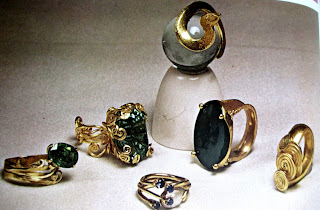vendredi 13 janvier 2017
aux Etats Unis
Le sujet est aussi vaste que le pays !
Il semble que ce soit aprés la crise des années trente que la joaillerie prenne son essor, propulsée par des expositions au Moma (Museum of Modern Art New-York) à Minneapolis au Walker Art Center qui présente une cinquantaine d'artistes et la volonté de Mrs Vanderbild Webb de promouvoir les oeuvres des créateurs et cela d'une façon définitive grâce à la fondation du Museum of Contemporary Crafts de New York en 1955.
L'American Craft Council met tout en oeuvre pour organiser des expositions dans plusieurs Etats et permettre aux artisans de réaliser leurs travaux.
C'est ainsi que nous trouvons dans l'Ohio à Cleveland, John Paul Miller qui maîtrise l'art de la granulation, figurant tous les animaux possibles en or et émaux soulignés de granulations.
https://www.clevelandart.org/events/exhibitions/jewelry-john-paul-miller
Mary Kretsinger se spécialise dans un bijou à réminiscence étrusque, petit globe creux à la décoration complexe d'émaux cloisonnés.
http://www.mschon.com/specialcollections/kretsingerjewelryfive.html
http://enamelarts.org/index.php?collection&action=view_artist&artist_id=64
Voici l'apparition d'une technique nouvelle, le bain électrolytique sur résine et c'est Stanley Lechtzin né à Détroit en 1936 qui sait en exploiter toutes les facettes.
J'ai une prédilection pour ce collier de style "préhistorique" (bien évidemment)
polyester et argent obtenu par bain électrolytique sur résine
même technique pour ce pendentif en argent doré obtenu par bain électrolytique sur résine avec améthystes et pierres de lune
https://www.youtube.com/watch?v=-pU9jnsHDuU
D'origine russe Iréne Brynner commença sa carrière en Suisse après avoir été sculpteur elle se consacre à la joaillerie et conçoit ses dessins avec symétrie.
Biographical/Historical Note: Irena Brynner (1917-2003) was a jeweler from New York, N.Y.
Brynner grew up in Vladivostok in Primorski Krai, Russia; her artistic family including her cousin Yul Brynner; fleeing from Russia to Darian (on the southern tip of the Liaotung peninsula, in the Kwantung Leased Territory of Manchuria); her art studies in Lausanne, Switzerland; her father's illness during World War II; moving with her mother to San Francisco in 1946; her studies with Ralph Stackpole and Franz Bergman in San Francisco; her relationship with architect Frank Merwin; teaching art in Catholic schools in San Francisco; her decision to make jewelry after seeing Claire Falkenstein's sculpture;
working as an apprentice to Caroline Rosene and Franz Bergman; forming the Metal Arts Guild with Bob Winston, Merry Renk, Florence Resnikoff, Margaret De Patta, and others; and introducing forging and three-dimensional jewelry in the Metal Arts Guild. She also talks about her move to New York City in 1957; acting as her own agent; "open-air art shows" in San Francisco; her first show at Walker & Eberling; starting her own shop; teaching at the Craft Students League and at MoMA's Institute of Modern Art, at Victor D'Amico's invitation, ca. 1962; her friendships with students and clients; her book, "Jewelry as an Art Form" (New York : Van Nostrand Reinhold, 1979) and its influence; learning to work with a Henes water welder; the treatment of women artists in America; her move to Geneva, Switzerland, in 1972, and the difficulties of starting a shop there; and her return to New York and reestablishing her career in the United States. Brynner also discusses her interest in singing, her voice lessons, her public performances of Russian classical music, and her health.
Il faut aussi mentionner d'autres artistes, comme Harry Shawah qui utilise les pierres précieuses :
http://www.legacy.com/obituaries/bostonglobe/obituary.aspx?pid=129251091
ou Philip Morton
qui confirme que tout peut mener à la joaillerie :
http://historycapture.com/Rosolowski_PMorton.pdf
Morton grew up in Ogden, Utah. He attended the University of Utah from 1939 to 1949 on scholarship. He received his B.A. Degree in sociology with a minor in psychology. He worked as an accountant for American Smelting and Refining in Salt Lake City from 1941 to 1943. In 1943, due to the war effort, Morton moved his family to Berkeley, California and worked as a foreman. During this period he opened a workshop in his basement and made jewelry. He studied contemporary art movements on his own. Morton started to sell his jewelry to some of the leading shops in his area. Soon after his success, he was invited to teach design at Alfred University at the School for American Craftsmen. After this position he taught at University of Minnesota. Morton taught three dimensional design, jewelry and sculpture. He established the first bronze foundry in any university art program in 1951. Morton devoted the next ten years of his life to bronze sculpture and jewelry making.
In 1956 Morton began to privately study the works of Carl Jung. There were no Jungians in New York City so he started to record and analyze his dreams. Morton moved to Jackson Hole, Wyoming in 1961. He sold his jewelry and worked as a land surveyor. He also designed houses. It was during this time he wrote and published his book, Contemporary Jewelry. After this he taught in the art department at University of Utah for three years. Next he worked as a goldsmith at a community college in Toronto. Soon he moved again to Bowling Green, Ohio and opened an apprenticeship program in metalwork and jewelry in 1970 to 1974. In 1974 Morton learned of Jungians in Chicago. He moved yet again and became interested in training programs in the Chicago area. Morton was advised to acquire a Masters Degree in clinical work. He received his M.A. in 1976 in Rehabilitation Counseling. Morton continued his education and then moved back to Bowling Green to open his own psychotherapy practice. He moved to Montana in 1980, into a house he previously designed and built. Since then, Morton has practiced in Montana and offered workshops on dream analysis
mais aussi Sam Kramer et beaucoup d'autres:
http://www.modernsilver.com/Walkerarticle.htm
http://www.walkerart.org/calendar/2016/jewelry-artist-mart-2
Inscription à :
Publier les commentaires (Atom)








Aucun commentaire:
Enregistrer un commentaire